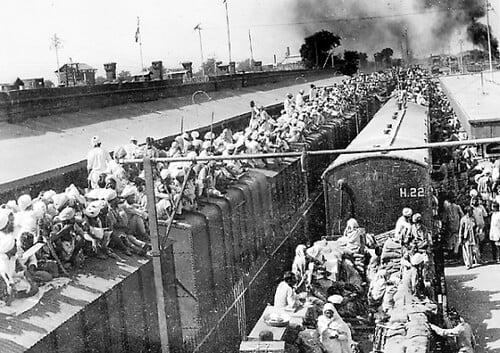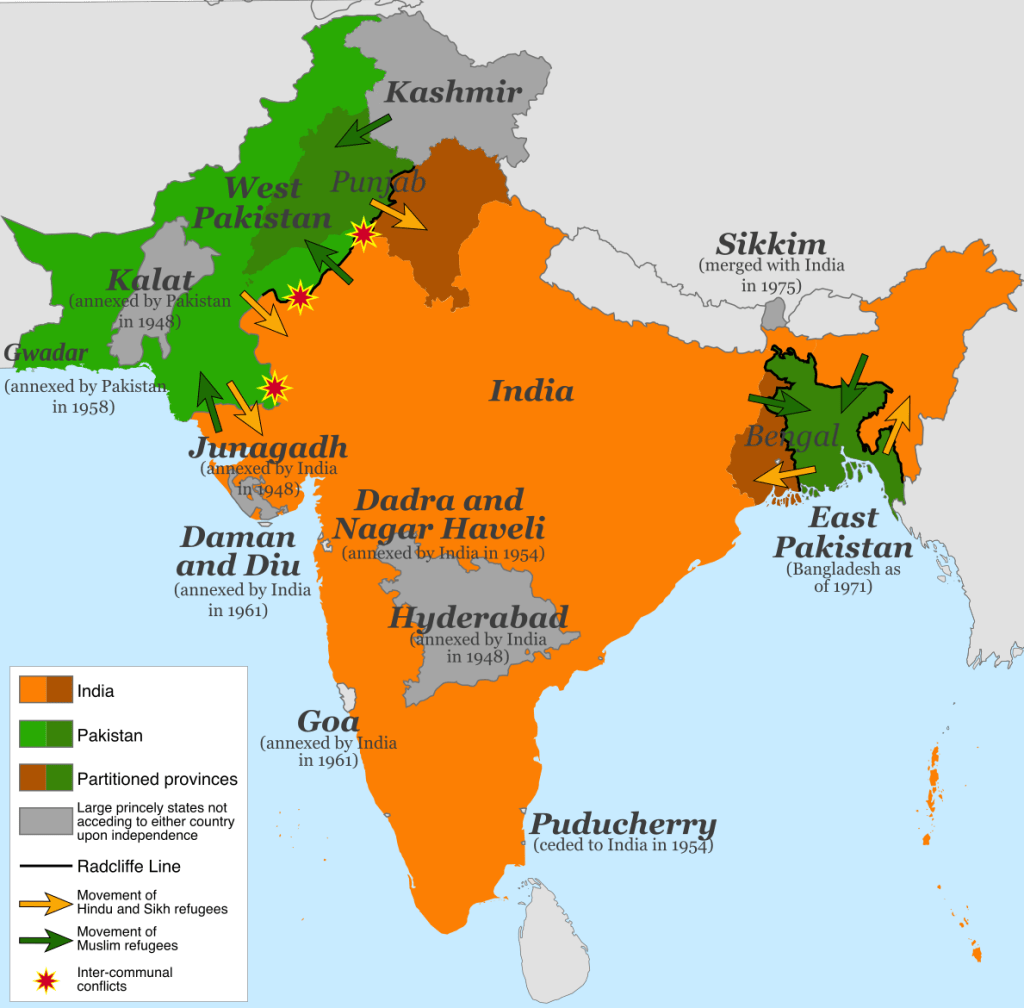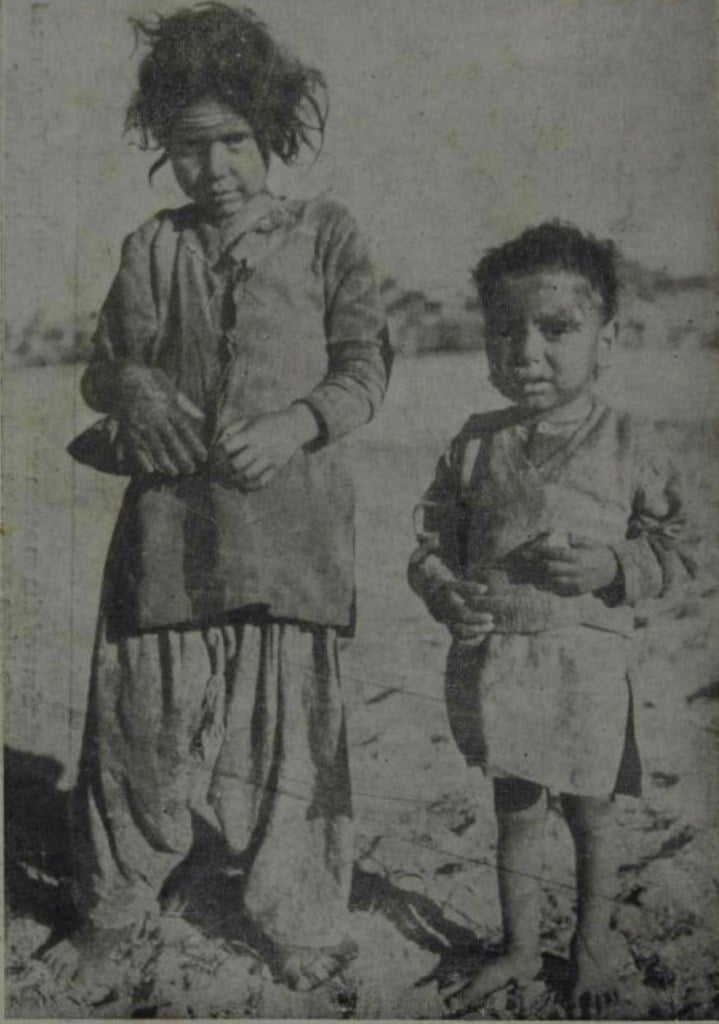There are no words to describe the horrors of the partition of India and Pakistan, and describing it as independence day can often feel facetious. But every year, it is marked on August 14th to August 15th, where the country was divided up following the end of British colonialism, forcing a mass migration of historic proportions. We look at books that map the consequences of the partition of India.
The day seems to always make me feel rather contemplative, torn between different loyalties as a British citizen. However I am the daughter of immigrants, and the granddaughter of a refugee as a direct result of this tragedy. Because that it is what it was – after all millions were displaced and hundreds of thousands lost their lives.
What is the partition of India?
The partition of India refers to the division of former British India into two separate countries, India and Pakistan, in 1947. This separation was based largely on religious lines, with India becoming a predominantly Hindu-majority nation and Pakistan being created as a homeland for Muslims. The partition led to significant violence, displacement, and loss of life. By 1948, as the great migration drew to a close, more than fifteen million people had been uprooted, and between one and two million were dead.

Why did they partition India?
The partition of India was primarily driven by a combination of religious, political, and social factors:
- Religious differences. The most significant factor was the religious divide between the Hindu and Muslim communities in India. Over time, tensions between these two groups had grown due to cultural, religious, and historical differences.
- Demand for separate homeland. The All-India Muslim League, led by Muhammad Ali Jinnah, advocated for the creation of a separate Muslim-majority nation in the Indian subcontinent. They believed that Muslims needed a separate homeland to protect their political, social, and cultural rights.
- British colonial rule. British colonial rule in India played a pivotal role in exacerbating religious tensions. The British implemented a policy of “divide and rule,” which exploited religious differences to maintain control. This policy inadvertently fuelled communalism and distrust between religious groups.
- Failed negotiations. Efforts to find a common ground between different communities failed, leading to the demand for separate states. The Cabinet Mission Plan of 1946 aimed to create a united India with decentralised power, but it was rejected by the parties involved.

Read: South Asian Heritage Month: 18 books to celebrate diaspora
- Mounting communal violence. In the lead-up to independence in 1947, violent clashes between Hindus and Muslims escalated, leading to further mistrust and fear. The escalating violence and communal riots played a significant role in pushing for partition.
- Geographical and demographic factors. India’s vast size and diverse population made it challenging to govern as a single entity. The demand for a separate Muslim state was influenced by the concentration of Muslims in certain regions, particularly in the northwest.
- Leadership and political goals. The leadership of key figures like Mahatma Gandhi, Jawaharlal Nehru, and Muhammad Ali Jinnah played a role in shaping the direction of events. Jinnah’s insistence on a separate Muslim state and Gandhi’s focus on Hindu-Muslim unity were contrasting approaches that contributed to the division.
- International pressure. World War II and the changing global political landscape influenced the British decision to withdraw from India. The British were also concerned about maintaining stability and preventing further violence, which influenced their approach to partition.
The culmination of these factors led to the decision to partition India into two separate countries, India and Pakistan, in 1947. The partition was a complex and contentious process that had profound implications for the entire region.

What was the consequences of partition?
The partition of India had profound and far-reaching consequences:
- Violence and displacement. The partition resulted in widespread violence and communal riots, leading to the loss of hundreds of thousands of lives and the displacement of millions of people. Many families were separated, and people were forced to leave their homes and move to the new countries based on their religious identities.
- Humanitarian crisis. The mass migration of people between India and Pakistan led to a severe humanitarian crisis. Many people faced hardship, lack of resources, and inadequate living conditions during their journeys.
- Cultural and religious shifts. The partition led to a significant cultural and religious shift in both countries. India emerged as a predominantly Hindu-majority nation, while Pakistan was established as a Muslim-majority nation. This had implications for the social fabric, traditions, and identities of these countries.
- Loss of lives and property. The violence and displacement resulted in the loss of lives, property, and wealth for many individuals and communities. Many cities and towns witnessed destruction and looting during this period.
- Long-standing tensions. The partition left behind deep-rooted tensions between India and Pakistan, which persist to this day. Conflicts over borders, especially in regions like Kashmir, have led to multiple wars and ongoing disputes.
Read: Why children should learn the truth – Stolen History author Sathnam Sanghera
- Refugee crisis. The mass migration of people led to the creation of large refugee populations in both countries. The resettlement and rehabilitation of these refugees posed significant challenges to the newly formed governments.
- Economic impact. The partition also had economic implications as industries, infrastructure, and trade routes were disrupted. Both countries had to rebuild their economies from scratch.
- Political changes. The partition marked the end of British colonial rule in the Indian subcontinent and led to the establishment of two separate countries with distinct political systems. India adopted a democratic system, while Pakistan initially had both East and West wings before eventually becoming two separate nations, Pakistan and Bangladesh.
- Legacy of division. The legacy of partition continues to influence the politics, culture, and society of India, Pakistan, and Bangladesh. It has shaped the way these nations view each other and their own identities.
India and Pakistan are worryingly both nuclear powers, fighting over much needed clean water as well as disputed territory in areas such as Jammu & Kashmir. Just in the past few years, a standoff intensified when a major exchange of gunfire and shelling erupted between Indian and Pakistani troops in November 2020 along the Line of Control which left at least 22 dead, including 11 civilians. And J&K is often treated like a buffer zone instead of a country in its own right, leaving citizens in extremely challenging situations. No one comes out a winner in this.
What my grandfather went through during partition

Dadu’s Partition Story

I have no pictures of my granddad, or Dadu as we called him in Bengali. The wispy white-haired, well-spoken gentleman that taught English and Chemistry in Kolkata, West Bengal, was often seen with a book in his hand. As a quiet but powerful professor, he managed to found his own college from scratch and wrote a book about his harrowing experiences, all while raising a family during wartime and famine in the 1970s.
The academic often used his pen as a weapon especially as a pacifist, and was able to protect his alleged Naxalite students amid a massacre, by unmasking the Communist Party’s (CPIM) pursuit of them in the area. He sheltered those same youths inside his home, alongside his children as a wave of bombings ensued. Undoubtedly, his experiences have been marred with violence and extremism – but for him, knowledge was power. I remember fiddling with my dilapidated Barbie as his fingers caressed and massaged my hair, all while telling me stories of our family’s past and our world’s history – continuing more than a millennia of oral tradition. (Two child survivors of the Rawalpindi massacre, 1947)
His own survival was based on the kindness of so-called enemies. Our family were originally from the Bangladesh side of the divide. But the overnight overhaul of the region left people scrambling for their lives, knowing that if you were Hindu, Muslim or Sikh in the wrong camp, you may not last the day. Hindu families in East Pakistan were left in precarious positions, and friends quickly changed allegiances – a tell-tale sign of things to come. And it was not any better in the Hindu faction. Villages considered enemy territory were razed to the ground, and there were between 500,000 to 1,000,000 deaths overall as a result.
Read: Jaipur Literature Festival 2023: climate change, colonialism and constitution
But the cheerful Muslim neighbour had other plans. He used the only means he had to transport my grandfather to India at great peril to himself. Hidden in a rickety barrel, the same container used to deliver milk every day to the young man, Dadu stayed quiet for hours as he made this treacherous journey. Leaving his entire life behind with only the few items in his pocket, he had to restart his life in a new world where he had to rely on the kindness of strangers and not the loyalty of old friends. He may have thought I was playing with Dolly, but I heard and remember everything. And even though he passed away in 2006, therefore leaving no digital footprint, Ramesh Chandra Dutta will always be part of India’s history.
So remember the people that flee to your countries for asylum. It is always out of necessity.
Best books on understanding partition in India and Pakistan
Here are some of the top nonfiction books about the partition of India and Pakistan. These books on partition looks at the effect on those from both India and Pakistan.
- The Great Partition by Yasmin Khan. This book provides a comprehensive overview of the partition, from its historical roots to its bloody aftermath. Khan draws on a wide range of sources, including government documents, personal accounts, and oral histories.
- The Other Side of Silence by Urvashi Butalia. This book is a collection of oral histories from women who lived through the partition. Butalia’s interviews provide a rare glimpse into the experiences of women during this time, and they are a powerful reminder of the human cost of the partition.
- In Freedom’s Shade by Anis Kidwai. This book is a personal memoir by Anis Kidwai, who was a witness to the partition and a prominent political figure. It provides an insider’s view of the events, emotions, and challenges faced during that time.
- Partition: The Long Shadow by Urvashi Butalia. This other book by Butalia examines the long-term repercussions of partition, exploring how it continues to shape the lives and identities of people in India, Pakistan, and Bangladesh.
Read: Desi Books Review: Gulzar’s Footprints on Zero Line
- The Partition of India by Ian Talbot and Gurharpal Singh. This book provides a balanced and comprehensive analysis of the partition’s causes, impact, and the larger context of South Asian history. It delves into both political and social aspects.
- The Punjab Bloodied, Partitioned and Cleansed: Unravelling the 1947 Tragedy through Secret British Reports and First-Person Accounts by Ishtiaq Ahmed. This book combines British archival records and personal accounts to uncover the horrors of the partition in the Punjab region.
- Footprints on Zero Line: Writings on the Partition by Gulzar. With this collection of poetry, fiction, and non-fiction on the Partition, the virtuoso artist has joined countless other writers in exploring personal and communal histories.
- Partition Voices by Kavita Puri. A compelling oral history of the Partition of India, revealing the personal stories and memories of those who lived through it.
- The Lost Homestead: My Mother, Partition and the Punjab by Marina Wheeler. This memoir is an insightful glimpse into the way small worlds are forever changed by the impersonal currents of history.
While these books offer a range of perspectives and in-depth explorations of the partition of India and Pakistan, there’s no doubt that that these wounds are ongoing for those living with intergenerational trauma. Consequently, our bodies all keep the score when it comes to war.
This article contains affiliate links in which we may receive a small commission at no extra cost to you. We have not been commissioned to review books and services.
[…] Read: Partition of India: best books to understand independence […]
[…] “Broken Threads,” which explores the lives of her grandparents amid the backdrop of the Partition. The book, a result of rigorous historical research and family stories, paints a vivid picture of […]